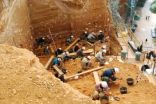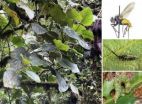(Press-News.org) Getting in the right shape might be just as important in a biology lab as a gym. Shape is thought to play an important role in the effectiveness of cells grown to repair or replace damaged tissue in the body. To help design new structures that enable cells to "shape up," researchers at the National Institute of Standards and Technology (NIST) have come up with a way to measure, and more importantly, classify, the shapes cells tend to take in different environments.*
With the notable exception of Flat Stanley, we all live, and are shaped by, a 3-dimensional world. Biologists have accepted that this dimensional outlook is just as important to growing cells. A key challenge in tissue engineering—the engineering of living cells to grow into replacement or repair tissues such as bone, heart muscle, blood vessels or cartilage—is creating 3-D scaffolds to support the cells as they grow and provide an appropriate environment so that they develop into viable tissue.**
This, says NIST materials scientist Carl Simon, has led to a large and rapidly expanding collection of possible 3D scaffolds, ranging from relatively simple gels made of collagen, the body's natural structural matrix, to structured or unstructured arrangements of polymer fibers, hydrogels and many more.
"What we're trying to measure," Simon explains, "is 'what is 3D in this context?' Presumably, a scaffold provides some sort of microenvironment—a niche that allows a cell to adopt the normal 3D morphology that it would have in the body. But you can't measure the niche because that's sort of an amorphous, ill-defined concept. So, we decided to measure cell shape and see how that changes, if it becomes more 3D in the scaffold."
The NIST team made painstaking measurements of individual cells in a variety of typical scaffolds using a confocal microscope, an instrument that can make highly detailed, 3-dimensional images of a target, albeit with very lengthy exposure times. They then used a mathematical technique—"gyration tensors"—to reduce each cell's shape to a characteristic ellipsoid. Ellipsoids can range in shape from points or spheres to flat ellipses or elongated sticks to something like an American football.
Analyzing the ellipsoid collection allowed them to categorize average cell shapes by scaffold. Cells in collagen gels and some fiber scaffolds, for example, tend toward a 1-dimensional rod shape. Other scaffolds promoted 2-dimensional disks, while a synthetic gel using a material called PEGTM* seems to encourage spheres.
"This technique," says Simon, "gives you a way to compare these different scaffolds. There are hundreds of scaffolds being advanced. It's hard to know how they differ with respect to cell morphology. By looking at the cell shape in 3D with this approach, you can compare them. You can say this one makes the cells more 3-dimensional, or this one makes the cells more like they would develop in collagen, depending on what you want. "
INFORMATION:
T.M. Farooque, C.H. Camp Jr., C.K. Tison, G. Kumar, S.H. Parekh, C.G. Simon Jr., Measuring stem cell dimensionality in tissue scaffolds. Biomaterials, Volume 35, Issue 9, March 2014. Available online Jan. 15, 2014. DOI:10.1016/j.biomaterials.2013.12.092
See, for example, the NIST news stories "Scaffold Gradients: Finding the Right Environment for Developing Cells" (May 2010) at http://www.nist.gov/mml/msed/hydrogel_052510.cfm and "NIST Announces New Scaffold Reference Material for Tissue Engineering Research" (June 2013) at http://www.nist.gov/mml/bbd/scaffold-062513.cfm. NIST work on 3D Tissue Scaffolds is described at http://www.nist.gov/mml/bbd/biomaterials/3dtissuescaffolds.cfm.
Poly(ethylene glycol) tetramethacrylate.
Shape-sifting: NIST categorizes bio scaffolds by characteristic cell shapes
2014-02-07
ELSE PRESS RELEASES FROM THIS DATE:
Computer models help decode cells that sense light without seeing
2014-02-07
Researchers have found that the melanopsin pigment in the eye is potentially more sensitive to light than its more famous counterpart, rhodopsin, the pigment that allows for night vision.
For more than two years, the staff of the Laboratory for Computational Photochemistry and Photobiology (LCPP) at Ohio's Bowling Green State University (BGSU), have been investigating melanopsin, a retina pigment capable of sensing light changes in the environment, informing the nervous system and synchronizing it with the day/night rhythm. Most of the study's complex computations were ...
Variability of contact precaution policies in US emergency departments
2014-02-07
In a study published in Infection Control and Hospital Epidemiology on February 7, 2014, Daniel J. Pallin, MD, MPH and Jeremiah D. Schuur, MD, MS, surveyed a random sample of US emergency departments (EDs) and found substantial variation in the adoption of policies relating to contact precautions.
While most EDs have policies relating to contact precautions when specific organisms are suspected, a minority have such policies for the symptoms often caused by those organisms. This indicated that institutional policies do not mirror consensus recommendations by the CDC, ...
Panel issues report on gray wolf science
2014-02-07
(Santa Barbara, Calif.) — As the Endangered Species Act (ESA) celebrated its 40th anniversary at the end of 2013, its administrative agency, the U.S. Fish and Wildlife Service (USFWS), was mired in controversy. At issue was a proposal to remove the gray wolf (Canis lupus) from the List of Endangered and Threatened Wildlife and add the Mexican gray wolf (Canis lupus baileyi).
As a result, the USFWS sought an independent peer review of the science behind the proposed rule to delist the gray wolf species. The agency commissioned UC Santa Barbara's National Center for Ecological ...
Study shows drop in crime rates are less where Wal-Mart builds
2014-02-07
Communities across the United States experienced an unprecedented decline in crime in the 1990s. But for counties where Wal-Mart built stores, the decline wasn't nearly as dramatic.
"The crime decline was stunted in counties where Wal-Mart expanded in the 1990s," says Scott Wolfe, assistant professor of criminology and criminal justice at the University of South Carolina and lead author of a new study. "If the corporation built a new store, there were 17 additional property crimes and 2 additional violent crimes for every 10,000 persons in a county."
The study, titled ...
Researchers at UGent and VIB, discovered potential novel treatment against septic shock
2014-02-07
Septic shock is caused by excessive and systemic reaction of the entire body against infectious agents, in most cases of bacterial origin. The number of deaths by septic shock in intensive care units is very high and is still increasing, despite numerous large scale clinical trials. Scientists of VIB and UGent, supervised by Peter Vandenabeele, demonstrated in a mouse study that a potential novel treatment for sepsis may consist of the simultaneous neutralization of two harmful cytokines in the blood circulation, namely interleukin-1 and interleukin-18.
In the VIB research ...
Dating is refined for the Atapuerca site where Homo antecessor appeared
2014-02-07
One of the issues of the Atapuerca sites that generates the most scientific debate is the dating of the strata where the fossils are found. Therefore, researchers at the Spanish National Research Centre for Human Evolution, among others, strive to settle the dates. A study published by the 'Journal of Archaeological Science' has clarified that the sediment of Gran Dolina, where the first remains of Homo antecessor were discovered in 1994, is 900,000 years old.
The findings at the Lower Palaeolithic cave site of Gran Dolina, in the Sierra de Atapuerca mountain range (Burgos), ...
Protein structure: Peering into the transit pore
2014-02-07
The lipid-rich membranes of cells are largely impermeable to proteins, but evolution has provided a way through – in the form of transmembrane tunnels. A new study shows in unmatched detail what happens as proteins pass through such a pore.
Every cell is surrounded by a surface membrane and contains internal compartments bounded by membranes. Almost one-third of all proteins synthesized in cells must pass through these membranes or be incorporated into them in order to fulfil their functions. However, the fat-rich nature of membranes makes it impossible for most proteins ...
Beta blockers and perioperative care: EHJ editorial addresses controversy
2014-02-07
Zurich, 7 February 2014. Since the end of 2011 when the scientific work of Professor Don Poldermans was first scrutinized there has been controversy in the medical world about the use of beta blockers in perioperative care.
The recent publication - and retraction for proper peer reviewing and revision - in the European Heart Journal (EHJ) of a paper by Professors Cole and Francis from Imperial College, questioning whether beta blockers in perioperative care could lead to a mortality increase brought the topic back into the public eye.
The EHJ has published an editorial ...
The biomass of ocean mesopelagic fish is 10 times higher than estimated
2014-02-07
The total stock of fish on the planet had been reckoned until today to be around 2,000 million tonnes. About half of them were thought to be mesopelagic fish, in other words, ones found at depths of between 200 and 1,000 metres in ocean areas.
However, an international team*, in which AZTI-Tecnalia researchers are participating and which is being led by the doctor in oceanography Xabier Irigoien, has discovered that its abundance could be at least 10 times higher than the original estimate. The results have been published in the journal Nature Communications.
Mesopelagic ...
New plant species a microcosm of biodiversity
2014-02-07
Biologists working in the Andes mountains of Ecuador have described a new plant species, a wild relative of black pepper, that is in itself a mini biodiversity hotspot. The new species, Piper kelleyi, is the sole home of an estimated 40-50 insect species, most of which are entirely dependent on this plant species for survival. This discovery is part of a larger project which focuses on the influence of plant-produced chemical compounds on biodiversity. The study was published in the open access journal PhytoKeys.
The chemical compounds produced by plants are source of ...




